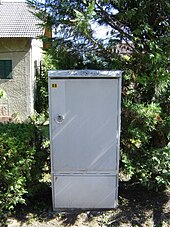Cable distributor
The cable distributor ( KVz ) is an approximately one meter high passive control cabinet for the distribution of cables within a local telephone network , which connects main cables with branch cables .
backgrounds
The cable distributor is usually on the roadside, is connected to the main distributor of the local exchange via the so-called main cable and carries the branch cables through which the surrounding houses are connected to the telephone network. Deutsche Telekom owns around 330,000 cable distributors, of which around 8,200 are used by competitors (as of 2014). These are currently mostly connected to the next main distributor via main cables consisting of twin copper wires . In the course of the expansion of the data transmission rate in the access network , cable distributors are increasingly being connected directly to the main distribution board via fiber optic cables .
Open, confusing cable distributor in London
Main cable and branch cable with 2000, 100 and 6 pairs .
Around 1920: Historic cable distributor in Hanover based on the Falke watch style
Depending on requirements, the individual cable conductors of the main and branch cables are connected together via jumper wires in the cable distributor ( " ranks ") . However, approaches are currently being developed to automate manual maneuvering with the help of remote-controlled switching matrices .
The use of cable distributors is not limited to the public telephone network; cable distributors are also used in extensive company premises (e.g. in lime works or stadiums).
Construction
If active technology (e.g. amplifier of the broadband network ) is installed in the cable junction box, this can lead to heat problems due to the closed construction. In this case, bases with ventilation slots or a passive climate roof, which dissipate the heat from the active network technology, provide a remedy.
Outdoor DSLAM

Locations in which no DSL or only very low DSL data transmission rates are possible are equipped with outdoor DSLAM if there is sufficient demand . For this it is necessary to connect these locations with fiber optic cables , which usually have to be re-laid. The outdoor DSLAMs are smaller than the indoor versions, but use the same connection modules (line cards) .
The DSLAM variant to be used will be decided after the local network has been expanded.
The German Telecom currently expanding street cabinet by providing a larger cabinet is placed over or next to (or in proximity of) the street cabinet to install an outdoor DSLAM, the above glass fiber is connected to the local exchange. These are also known as multifunctional housings (MFG). This makes it possible to supply subscribers with VDSL connections that can have a data transmission rate of 50 Mbit / s and more (connections up to 250 Mbit / s are marketed). The VDSL implementation is installed in the KVz. There are special outdoor DSLAMs for OPAL expansion areas, as the OPAL devices are connected to the exchange via fiber optics, but these only transmit the frequency range up to ~ 120 kHz ( ISDN bandwidth) into the glass network. Using this technology, areas that are connected to the network via an OPAL line can also be supplied with DSL. Outdoor DSLAMs are also installed for this and the cable distributors are retrofitted with them.
In some areas the DSLAM will convert the analogue signals of the telephone calls into VoIP , so that the connection to an exchange can be saved. Their task is then taken over by the DSLAM and the downstream technology for routing the IP packets.
Trivia
- With a test handset for suppressors , technicians can make long distance calls at a cable splitter.
- Often, due to their similarity, they are confused with cable junction boxes , the so-called mail storage or depot boxes from Deutsche Post AG.
Web links
- Picture collection of the OpenStreetmap-Wiki on the different housing types in Germany and elsewhere
Individual evidence
- ↑ Vectoring: Boost for broadband expansion in Germany. Retrieved February 28, 2020 .
- ↑ http://www.ftd.de/technik/it_telekommunikation/:Arcor%20VDSL%20Netz/279358.html ( Memento from November 17, 2007 in the Internet Archive )








